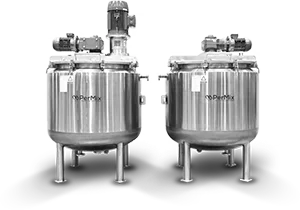Industrial Mixers
PerMix News & Updates


To Spray Or Not To Spray, That Is The Question. The Advantages Of Using Spray Nozzles To Add Liquids Into Powders During Mixing
From pharmaceuticals & foods to chemicals & cosmetics, mixing ingredients together often requires the mixing of powders & liquids. The way we add liquid into powders during the mixing process can extend the mixing process if not done correctly. Many times you will see liquids being added by simply pouring or “dripping” them into the batch. This form is adding liquids into powder mixers is not a good practice. Droplet size or particle size of the liquid has everything to do with how the powders are affected. We want the powders to absorb the liquid, not the liquid to absorb the powder. When we simply pour ar drip the liquid in, the particle size is larger than that of the powder and what happens is the powder is drawn to the liquid and forms clumps.
By reducing the particle size and reducing the surface tension of the liquid by using spray nozzles and different pressures, we can eliminate clumping and decrease the amount of time it takes powders to absorb the liquid. The size of the powder particles will suggest what type of nozzles to use and the amount of pressure needed at the pump. The higher the pressure of the pump, the more the liquid is atomized. Several different options are available.
An additional advantage of using pumps and spray nozzles to add liquids into powders is that it optimizes the efficiency of the liquids and absorption rates, allowing you to use less liquid. It will also optimize batch control and consistency, and minimize mixing & drying times if mixing & drying.
Here is a video of our PerMix Paddle Mixer with liquid additive manifold and nozzles. The unit was equipped with a dosing pump that supplied the manifold. Not that the manifold and nozzles can be broken down with no tolls by using the Tri-Clover sanitary type clamps.
Come see the PerMix difference.
#pharmaceuticals#cosmetics#food#foodmanufacturing#powdermixing#powdermixers